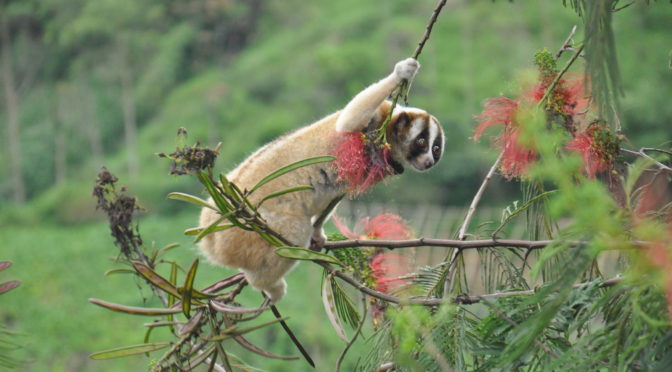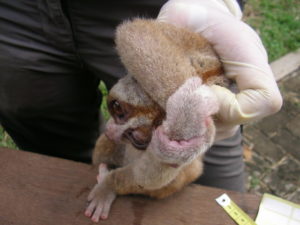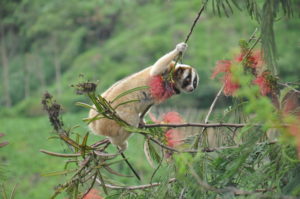New research assessing slow loris handedness in the wild and in captivity has been published this week (Monday 2 April). A team of researchers from Oxford Brookes University and the Little Fireface Project analysed photos of slow lorises in their bilateral venom pose and spontaneous reaching and grasping events to determine if they displayed a handedness preference.
Dr Stephanie Poindexter, who completed her PhD at Oxford Brookes University in collaboration with the Little Fireface Project was the lead author of the study, she said:
“For me slow lorises are such an unexpected primate, finding that some of the study animals showed a right-hand preference was yet another instance where slow lorises go against the theory.”
Our observations of a right-hand preference in reach and grasping tasks in both wild and captive slow lorises marks an interesting turn in how we understand the evolution of handedness in primates. There is a large literature on handedness in primates and other animals, but as we discover varying factors that can affect handedness we should be sure to assess species in varying conditions to see the full picture. Here we used three tasks/ positions including the bilateral venom pose. Few primates are tested in bilateral positions, which in humans does not elicit the same universal right-hand dominance as other manual tasks. This was a unique assessment in primates, especially in a strepsirrhine.
Co-author Prof Anna Nekaris, said: “I was initially inspired to participate in this study because the venom pose of the slow loris is so unique – no other primates regularly clasp their arms above their head so tightly. Lack of laterality in this particular position leads to more fascinating questions about the amount of venom yielded by the loris before they bite.”
One co-author of the study Katie Reinhardt, who collected data on the wild Javan slow lorises included in the study, commented: “Slow lorises are unique in so many ways, but their precision grip has always captivated me. They have the ability to grasp and forage for nectar on such small, terminal branches – especially the leguminous plant Calliandra calothrysus. This foraging technique requires high levels of manual dexterity, and yet they forage on these floral nectars without ever damaging a single flower. As we found wild slow lorises to display a right-handed preference in this specific foraging technique, this behaviour may have shaped primate evolution, both in handedness and the grasping hand in primates.”
The study was largely made possible by a number of funders and zoo/sanctuaries that allowed us to access the slow lorises in their care. The more we can learn about these primates the better we can care for them and work towards their conservation.
The research paper is published by the scientific journal Laterality: Asymmetries of Body, Brain and Cognition and can be found here.



